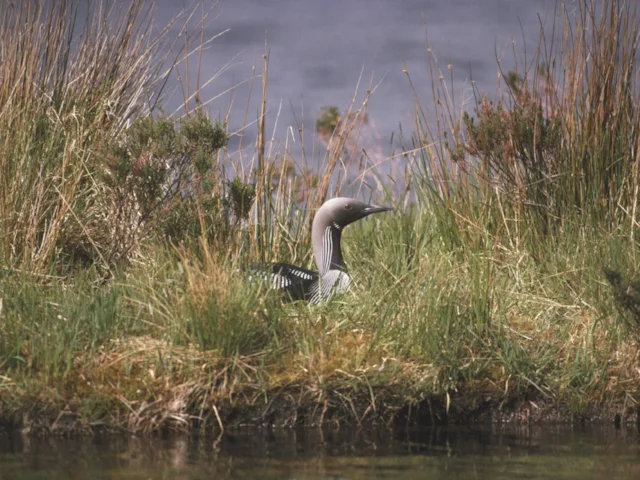'Life rafts' for Black-throated Divers
f7ec6560-79ce-46d2-b1b2-1254baccec8c

A pioneering project on Scottish lochs to create nesting rafts for one of Scotland’s rarest birds has met with remarkable success.
The Black-throated Diver, a species that only breeds in freshwater lochs in the north-west of the country, is benefiting from the scheme to create floating rafts that provide the necessary conditions for it to nest and raise chicks.
Although graceful in the water, it’s a different story for the bird on land. Black-throated Divers have to nest close to the water’s edge as their legs are set so far back on their bodies that they are very poor at walking, and shuffle around on their bellies instead. This makes the birds highly susceptible to changes in water level, often on lochs used to generate hydro-electric power. If water levels are too high, the nests are prone to flooding, and if too low, adult birds are unable to reach their nests when returning from feeding.
Conservationists devised the unique system of tethered floating rafts covered in vegetation to provide stable breeding habitat and have partnered with landowners to implement them throughout the region.
The efforts appear to be working. Since the introduction of the raft programme in the late 1980s, the Black-throated Diver breeding population has gradually risen from a low of 180 pairs to 240 pairs in 2012.
Stuart Benn, RSPB Scotland Conservation Manager, said: “Black-throated Divers are arguably the most stunning of British birds: a gorgeous, sleek combination of black, grey and white, with never a feather out of place. It's fantastic to see these charming birds successfully breeding on our lochs. This is a great example of how, through simple measures we can have a huge impact on the success of a struggling species. Thanks to our partnership with landowners, we are able to provide a safe haven for these birds and the conditions they need to thrive."
The Black-throated Diver, a species that only breeds in freshwater lochs in the north-west of the country, is benefiting from the scheme to create floating rafts that provide the necessary conditions for it to nest and raise chicks.
Although graceful in the water, it’s a different story for the bird on land. Black-throated Divers have to nest close to the water’s edge as their legs are set so far back on their bodies that they are very poor at walking, and shuffle around on their bellies instead. This makes the birds highly susceptible to changes in water level, often on lochs used to generate hydro-electric power. If water levels are too high, the nests are prone to flooding, and if too low, adult birds are unable to reach their nests when returning from feeding.
Conservationists devised the unique system of tethered floating rafts covered in vegetation to provide stable breeding habitat and have partnered with landowners to implement them throughout the region.
The efforts appear to be working. Since the introduction of the raft programme in the late 1980s, the Black-throated Diver breeding population has gradually risen from a low of 180 pairs to 240 pairs in 2012.
Stuart Benn, RSPB Scotland Conservation Manager, said: “Black-throated Divers are arguably the most stunning of British birds: a gorgeous, sleek combination of black, grey and white, with never a feather out of place. It's fantastic to see these charming birds successfully breeding on our lochs. This is a great example of how, through simple measures we can have a huge impact on the success of a struggling species. Thanks to our partnership with landowners, we are able to provide a safe haven for these birds and the conditions they need to thrive."

